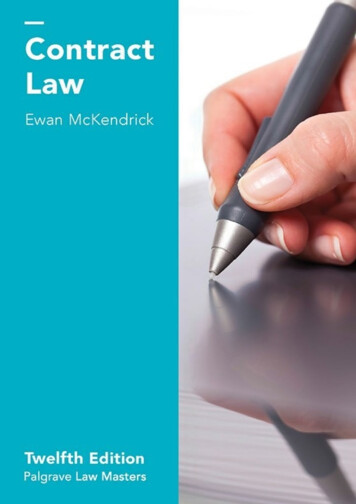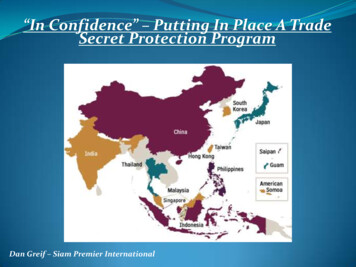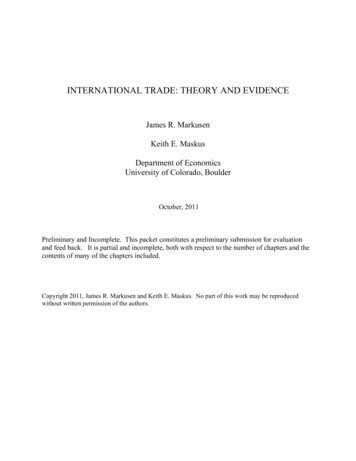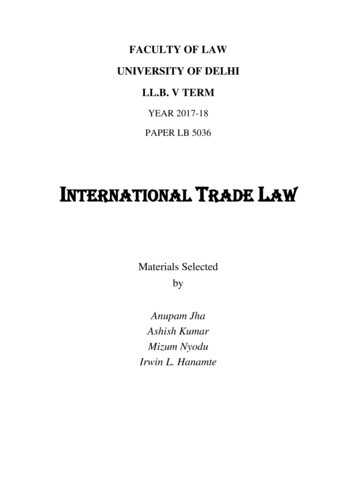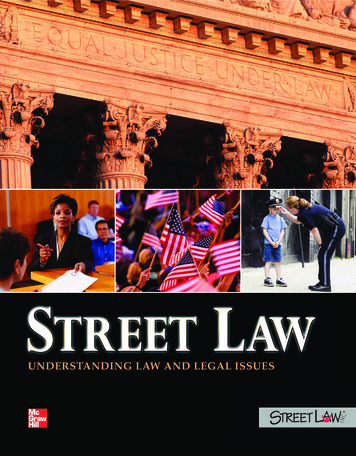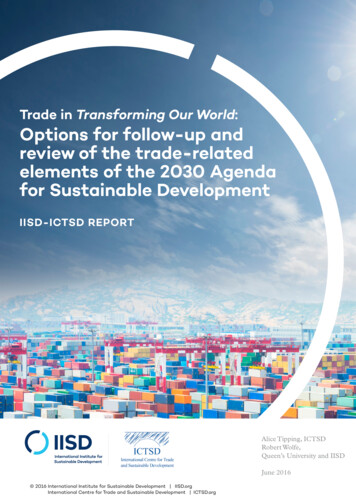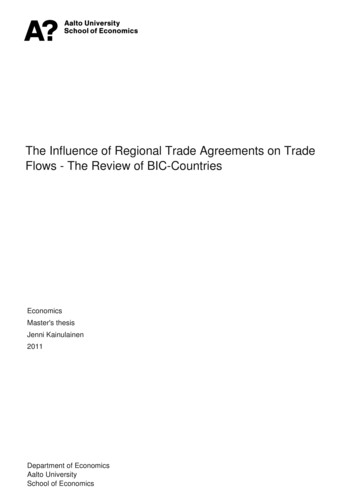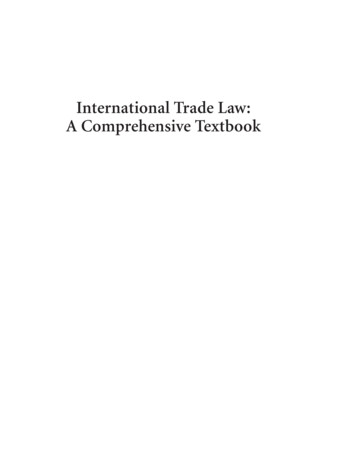
Transcription
International Trade Law:A Comprehensive Textbookbhala intl vol1 flip1.indb 12/7/19 3:23 PM
bhala intl vol1 flip1.indb 22/7/19 3:23 PM
International Trade Law:A Comprehensive TextbookVolume One:Interdisciplinary Foundationsand Fundamental Obligationsfifth editionRaj BhalaBrenneisen Distinguished ProfessorThe University of Kansas, School of LawLawrence, KansasSe nior AdvisorDentons U.S. LLPKansas City, Missouri“On Point” ColumnistBloomberg QuintMumbai, IndiaCarolina Academic PressDurham, North Carolinabhala intl vol1 flip1.indb 32/7/19 3:23 PM
Copyright 2019Raj BhalaAll Rights 1-5310-1426-1LCCN 2018968049The views of the Author do not necessarily reflect those of the University of Kansas,Dentons, BloombergQuint, or any other institution with which the Author is or hasbeen affiliated, nor do they necessarily reflect any clients of these entities.Carolina Academic Press, LLC700 Kent StreetDurham, North Carolina 27701Telephone (919) 489-7486Fax (919) 493-5668www.cap-press.comPrinted in the United States of Americabhala intl vol1 flip1.indb 42/7/19 3:23 PM
For Shera and Her Generation,That They Are Not Scourged by Poverty, Extremism, or a Clash of Civilizations,But Rather Blessed by Peace through Sustainable Trade and Development.And for the Glory of God.bhala intl vol1 flip1.indb 52/7/19 3:23 PM
bhala intl vol1 flip1.indb 62/7/19 3:23 PM
Summary of ContentsPart and Chapter titles are for all four Volumes of International Trade Law, FifthEdition. Please see individual Volumes for detailed Table of Contents.Volume OneInterdisciplinary Foundations andFundamental ObligationsAcknowl edgmentsNote on PedagogyNote on SourcesPreface to 5th EditionIntroduction: 10 PropositionsPart One: Moral Foundations of Free TradeChapter 1 Philosophical and Religious TheoriesChapter 2 Four Types of JusticeChapter 3 Theory and Practice of EthicsPart Two: Transactional Foundations of Free TradeChapter 4 Documentary SaleChapter 5 Trade FinancePart Three: Economic Foundations of Free TradeChapter 6 Classical and Neo-Classical Free Trade TheoryChapter 7 Modern Free Trade TheoryChapter 8 Questioning Capitalist Free Trade TheoryChapter 9 Communist Trade TheoryChapter 10 Trade PatternsChapter 11 Trade and Factors of ProductionChapter 12 Economics of ProtectionPart Four: Historical Foundations of Free TradeChapter 13 American Trade HistoryChapter 14 Presidential Powers and TradeChapter 15 GATT Rounds through 1970sChapter 16 Uruguay Round (1986–1994) and Birth of WTO (1995)Chapter 17 Doha Round (November 2001–March 2018)viibhala intl vol1 flip1.indb 72/7/19 3:23 PM
viiiSUMMARY OF CONTENTSPart Five: Institutional Foundations of Free TradeChapter 18 Structure of WTO and GATT-WTO LawChapter 19 GATT-WTO Accession ProcessChapter 20 WTO Accession Case StudiesPart Six: Adjudicatory Foundations of Free TradeChapter 21 Pre-Uruguay Round GATT Civil Procedure (1948–1994)Chapter 22 Post-Uruguay Round WTO Civil Procedure (1995–)Chapter 23 Participation and Capacity ProblemsChapter 24 Resource and Interpretation ProblemsChapter 25 Enforcement ProblemsPart Seven: Product Relationships for Legal Foundations of Free TradeChapter 26 Like ProductsChapter 27 Directly Competitive Or Substitutable ProductsPart Eight: Legal Foundations of Free Trade: Five Pillars of GATT-WTO LawChapter 28 First Pillar: GATT Article I and MFN TreatmentChapter 29 Second Pillar: GATT Article II and Tariff BindingsChapter 30 Second Pillar (Continued): Tariff ChangesChapter 31 Third Pillar: GATT Article III:1-2 and National Treatment forFiscal MeasuresChapter 32 Third Pillar (Continued): GATT Article III:4 and NationalTreatment for Non-Fiscal MeasuresChapter 33 Fourth Pillar: GATT Article XI and QRSChapter 34 Fourth Pillar (Continued): GATT Article XIII andAdministering QRSChapter 35 Fourth Pillar (Continued): TBTs as NTBsChapter 36 Fifth Pillar: GATT Article X and TransparencyPart Nine: Exceptions: Cracks in Pillars of GATT-WTO LawChapter 37 Non-Application, Waivers, Preferences, And RemediesChapter 38 GATT Articles XII and XVIII and Bop CrisesChapter 39 GATT Article XX General ExceptionsChapter 40 GATT Article XX(a) Morality Exception: Islamic Jurisdictions,Alcohol, and PornographyChapter 41 GATT Article XX(a) Morality Exception (Continued): AnimalRights and Money LaunderingChapter 42 GATT Article XX(a) Morality Exception (Continued): CensorshipPart Ten: Trade and AgricultureChapter 43 Ag Market AccessChapter 44 Ag Export SubsidiesChapter 45 Domestic Ag SupportChapter 46 Green Box ControversiesChapter 47 SPS Measuresbhala intl vol1 flip1.indb 82/7/19 3:23 PM
SUMMARY OF CONTENTSixPart Eleven: Trade and ServicesChapter 48 Services Classifications and Supply Modes (GATS Parts I, V–VI)Chapter 49 General Obligations And Exceptions (GATS Part II)Chapter 50 Specific Commitments And Exceptions (GATS Parts III–IV)Volume TwoCustoms Law and National SecurityPart One: Country of OriginChapter 1 MarkingChapter 2 Non-Preferential Rules of OriginChapter 3 Classic Marking DisputesPart Two: Entry of MerchandiseChapter 4 Types of EntryChapter 5 Foreign Trade ZonesPart Three: Customs ClassificationChapter 6 Tariff SchedulesChapter 7 Conceptual Classification CategoriesChapter 8 Classification ConundrumsChapter 9 More Classification ConundrumsPart Four: Customs ValuationChapter 10 Valuation MethodologiesChapter 11 Valuation ConundrumsPart Five: Special Customs Law OpportunitiesChapter 12 DrawbackChapter 13 Pre-Shipment InspectionChapter 14 Trade FacilitationPart Six: Border SecurityChapter 15 Post-9/11 Customs Law Paradigm ShiftChapter 16 Post-9/11 Border Security InitiativesPart Seven: Defining “National Security”Chapter 17 Multilateral and American Legal FrameworksChapter 18 Section 232Part Eight: Trade SanctionsChapter 19 Morality of Trade SanctionsChapter 20 Iran Trade Sanctions: 1979 Hostage Crisis–2012Chapter 21 Iran Trade Sanctions (Continued): Increasing the Pressure andGetting a Deal, 2012–2018Chapter 22 Iran Trade Sanctions (Continued): 2018 Iran Nuclear DealWithdrawal and Aftermathbhala intl vol1 ch00 fm flip1.indd 92/20/19 11:12 AM
xSUMMARY OF CONTENTSPart Nine: Export ControlsChapter 23 Nuclear ItemsChapter 24 Military GoodsChapter 25 Dual Use ItemsVolume ThreeRemediesPart One: Remedies against “Unfair” Trade: Antidumping LawChapter 1 Political Economy of Dumping and Ad DutiesChapter 2 Procedures: Original Investigations through Final DeterminationsChapter 3 Procedures (Continued): After Final DeterminationsChapter 4 Data Issues in Ad CasesChapter 5 Dumping Margin CalculationChapter 6 Dumping Margin Calculation Issues: Viability, Below-Cost Sales,and Merchandise ComparisonsChapter 7 Dumping Margin Calculation Issues (Continued): Proxies forNormal ValueChapter 8 Dumping Margin Adjustments: Adjustments to Normal ValueChapter 9 Dumping Margin Adjustments (Continued): Adjustments toExport Price or Constructed Export PriceChapter 10 InjuryPart Two: Remedies against “Unfair” Trade (Continued): CountervailingDuty LawChapter 11 Political Economy of Subsidies and CVDsChapter 12 Definition of “Subsidy,” First Element: “Financial Contribution”Chapter 13 Definition of “Subsidy,” Second Element: “Benefit” ConferredChapter 14 Definition of “Subsidy,” Third Element: Specificity TestChapter 15 Traffic Light System: Red Light (Prohibited) SubsidiesChapter 16 Traffic Light System (Continued): Yellow Light (Actionable)SubsidiesChapter 17 CVDs against Pre-Privatization SubsidiesPart Three: Remedies against “Unfair” Trade (Continued): Causation inAntidumping and Countervailing Duty CasesChapter 18 Theories of CausationChapter 19 Proving Causation: GATT-WTO JurisprudenceChapter 20 Proving Causation (Continued): American JurisprudencePart Four: Disciplines on Fishing SubsidiesChapter 21 Issues and ConsequencesChapter 22 Post-2013 Bali Ministerial Conference Effortsbhala intl vol1 flip1.indb 102/7/19 3:23 PM
SUMMARY OF CONTENTSxiPart Five: Remedies against “Fair” Trade: SafeguardsChapter 23 Rationales for SafeguardsChapter 24 Legal Criteria for General SafeguardsChapter 25 America’s Safeguard: Section 201 Escape ClausePart Six: Remedies against Non-Market EconomiesChapter 26 AD Cases against NMEsChapter 27 CVD Cases against NMEsChapter 28 Market DisruptionPart Seven: Unilateral RemediesChapter 29 Rationales for Unilateral RetaliationChapter 30 Section 301Chapter 31 Section 301 and Sino-American Trade WarPart Eight: Currency ManipulationChapter 32 GATT Article XV and IMF Article IVChapter 33 Alternative StrategiesVolume FourPreferences, Labor, and the EnvironmentPart One: Rationales for FTAsChapter 1 Economic Aspects of FTAsChapter 2 Political Aspects of FTAsChapter 3 National Security Aspects of FTAsPart Two: Common Legal Features of FTAsChapter 4 GATT-WTO Disciplines on FTAsChapter 5 Special Disciplines for India and PakistanChapter 6 Preferential ROOsChapter 7 Preferential ROOs (Continued): NAFTA Case StudyChapter 8 Preferential ROOs (Continued): Additional IssuesPart Three: Legal Commitments in FTAsChapter 9 Typical FTA Market Access ObligationsChapter 10 Liberalizing Services Trade through FTAsChapter 11 Liberalizing and Protecting FDI through FTAsChapter 12 Additional Commitments in “Deep” FTAsPart Four: Preferences for Poor Countries: Development EconomicsChapter 13 Measuring Growth, Development, and PovertyChapter 14 Economic Growth Models: Stages Of Growth and Sources ofGrowthChapter 15 Economic Growth Models (Continued): Industrialization andLabor Surplusbhala intl vol1 flip1.indb 112/7/19 3:23 PM
xiiSUMMARY OF CONTENTSChapter 16 Trade Policy, Growth, and Poverty: Export OrientationChapter 17 Trade Policy, Growth, and Poverty (Continued) ImportSubstitutionChapter 18 Modern Indian Trade HistoryPart Five:Preferences for Poor Countries (Continued): Trade LawsChapter 19 Special and Differential TreatmentChapter 20 Generalized System of PreferencesChapter 21 Special Help for Africa?Part Six: Trade And LaborChapter 22 International Labor Law and Trade RestrictionsChapter 23 Substantive Labor Obligations in FTAsChapter 24 Resolving Labor Disputes under FTAsChapter 25 Theory of TAAChapter 26 Practice of TAAPart Seven: Trade and the EnvironmentChapter 27 GATT Article XX(b) and XX(g) JurisprudenceChapter 28 Environmental Provisions in FTAsChapter 29 Trade and Climate ChangePart Eight: Trade and Intellectual PropertyChapter 30 IP OverviewChapter 31 Substantive Trips Agreement ObligationsChapter 32 Compulsory Licensing, Evergreening, and PatentedPharmaceuticalsChapter 33 IP Enforcementbhala intl vol1 flip1.indb 122/7/19 3:23 PM
ContentsAbout the Author Table of AbbreviationsAcknowl edgmentsNote on PedagogyNote on SourcesxxvxxviilxilxiiilxviiPreface to 5th EditionInterdisciplinary and TechnicalNot Geneva- CentricCurriculum Revolutions and the Canon of International Trade LawNon- Western OrientationTo Propose, Not ImposeTPP, T- TIP, TPA, TISA, and EGAInvitation to duction: 10 PropositionsProposition 1: Promote Growth and Alleviate PovertyProposition 2: Secure New Fragile Middle ClassProposition 3: Appreciate Non- Western FutureProposition 4: Eu rope Is HaggardProposition 5: Advance Social JusticeProposition 6: Understand SchismsProposition 7: See DichotomiesProposition 8: National Security M attersProposition 9: Pay Special Attention to India and ChinaProposition 10: Be cviiciChapter 1 · Philosophical and Religious TheoriesI. Why Trade? Plutarch versus HoraceII. Are Traders Immoral? Plato, Cicero, and the Early Christian F athersIII. Doctrine of Universal EconomyIV. Peace Through Trade or Trade After Peace? Bastiat, Montesquieu,Cobden and Hull versus Keynes, History, and ExpectationsV. Con temporary Doubts about Peace through Trade3345712xiiibhala intl vol1 flip1.indb 132/7/19 3:23 PM
xivbhala intl vol1 flip1.indb 14CONTENTSChapter 2 · Four Types of JusticeI. General DefinitionII. Commutative JusticeIII. Distributive JusticeIV. Legal JusticeV. Social JusticeVI. Four Moral Pillars of Catholic Social Justice Theory15151516161718Chapter 3 · Theory and Practice of EthicsI. Two Analytical AxesII. Utilitarian Theory (Act and Rule)III. Virtue Ethics TheoryIV. Deontological TheoryV. Overview of 1977 FCPAVI. Application of FCPAVII. 2010 U.K. Bribery ActVIII. 1998 OECD Anti- Bribery ConventionIX. Ethical Conduct in American Trade PracticeX. Ethical Conduct in GATT- W TO Practice3131323334354164646769Chapter 4 · Documentary SaleI. Species of International Commercial TransactionsII. Risks AboundIII. Three Levels and Private- Public DistinctionIV. PartiesV. DocumentsVI. StepsVII. Hy po thet i cal Documentary Sale Transaction7373747879839298Chapter 5 · Trade FinanceI. Overview and L/C versus Open AccountII. ExampleIII. UCPIV. ExampleV. L/C Drafting and FeesVI. Drafts and Bankers Ac cep tancesVII. Money MarketVIII. Alternative Types of L/CsIX. Seminal L/C Cases103103105106110113114122127128Chapter 6 · Classical and Neo- Classical Free Trade TheoryI. MercantilismII. Adam Smith and Absolute AdvantageIII. David Ricardo’s Law of Comparative Advantage in BriefIV. Division of Labor, Not Job CreationV. Classical Arithmetic Demonstration of Comparative Advantage1491491511561571582/7/19 3:23 PM
CONTENTSVI. Five Key Microeconomic Concepts for Comparative AdvantageVII. Neo- Classical Graphical Demonstration of Comparative AdvantageVIII. Exports as Price of Imports and 1990s Indian Economic Reformsxv162170180Chapter 7 · Modern Free Trade TheoryI. CGE Modeling of Effects of F ree TradeII. Static versus Dynamic ModelsIII. Dynamic Gains from Trade Liberalization: Savings and InvestmentIV. Dynamic Gains from Trade Liberalization: Additional Growth Sources183183185186187Chapter 8 · Questioning Cap i tal ist Free Trade TheoryI. 20 Assumptions Under lying Comparative AdvantageII. New Trade Theory and Increasing Returns to ScaleIII. Questionable AssumptionsIV. Infant Industry ProtectionV. Revitalizing Ailing Domestic IndustriesVI. Strategic Trade Policy and Managed Trade191191196197198199201Chapter 9 · Communist Trade TheoryI. Marxist- Leninist Critique of F ree TradeII. Step 1: Competition, Exploitation, and SurplusIII. Step 2: Search for New MarketsIV. Extracting SurplusV. Step 4: Unholy AlliancesVI. Industrial Policy203203204209211212214Chapter 10 · Trade PatternsI. Studying Trade PatternsII. Heckscher- Ohlin TheoremIII. Leontief Paradox and Empirical Tests of Heckscher- Ohlin TheoremIV. Theory of Monopolistic CompetitionV. Product Life Cycle Hypothesis217217217220223223Chapter 11 · Trade and F actors of ProductionI. Links among Trade, Jobs, and WagesII. F actor Price Equalization TheoremIII. Stolper- Samuelson TheoremIV. World Bank, WTO, ILO, and OECD Empirical ResearchV. “China Effect”?227227233238241242Chapter 12 · Economics of ProtectionI. Defining “Trade Barriers”II. Three Tariff TypesIII. Tariff Peaks, Escalation, and InversionIV. ERPV. Classical and Neo- Classical Economic Tariff Analy sisVI. Optimum Tariff ArgumentVII. Neo- Classical Economic Quota Analy sis245245245246248252265270bhala intl vol1 flip1.indb 152/7/19 3:23 PM
xvibhala intl vol1 flip1.indb 16CONTENTSChapter 13 · American Trade HistoryI. Pre- Revolutionary Colonial StatusII. American Revolution, Boston Tea Party, and In de pen denceIII. Smuggler Nation?IV. Constitutional Compromise on SlaveryV. Early American Trade LawsVI. Pre- Civil War B attles Over Tariff Policy between North and South,and Tariff of AbominationsVII. Trade Policy from 1870s to 1930 Smoot- Hawley Tariff ActVIII. Three Patterns293296300Chapter 14 · Presidential Powers and TradeI. Foreign Commerce Clause (Article I, Section VIII, Clause 3)II. Del e ga tion Doctrine CasesIII. Presidential Trade Negotiating Authority303303304309Chapter 15 · GATT Rounds through 1970sI. 1929–1945: Depression, Isolationism, and WarII. 1946–1948: Birth of GATT, Stillbirth of ITOIII. Poor, Islamic, and Development- Oriented DiversityIV. Trends in RoundsV. 1948–1961: Early GATT RoundsVI. 1964–1967: Kennedy RoundVII. 1973–1979: Tokyo RoundVIII. Per sis tent Prob lems of Currency Misalignment and Trade Wars325325331334335339346351355Chapter 16 · Uruguay Round (1986–1994) and Birth of WTO (1995)I. Non- Tariff IssuesII. Industrial Tariff CutsIII. “ Grand Bargain”IV. WTO Birth and Key DatesV. Breakdown of Grand Bargain357357359364364364Chapter 17 · Doha Round (November 2001– March 2018)I. Schisms with Diversity from GATT Contracting Parties toWTO MembersII. November 2001 DDA ItemsIII. Open IssuesIV. Grand Bargain Re- ThinkV. GATT Preamble and Trade as Counter- TerrorismVI. Trade Liberalization, Poverty Alleviation, and Islamist ExtremismVII. Implausible Regression AnalysesVIII. Intent of DDA NegotiatorsIX. Per sis tent ThreatX. Death, but Four 3913973992/7/19 3:23 PM
CONTENTSxviiChapter 18 · Structure of WTO and GATT- W TO LawI. Three Legs of WTOII. WTO Institutional StructureIII. Structural FlawsIV. Content of WTO Agreement and Four AnnexesV. Post- Uruguay Round Deals405405407415416419Chapter 19 · GATT- W TO Accession Pro cessI. Accession and Original GATT Contracting PartiesII. Two- Step Accession Pro cessIII. False Promises? H uman Rights and Religious FreedomIV. GATT Article XXVI:5(c) Sponsorship AccessionV. July 2012 Decision on Accession of LDCsVI. Changing TermsVII. Breaking Away423423425428429430433436Chapter 20 · WTO Accession Case StudiesI. Enter the Dragon (China)II. Chinese Accession: Lop- Sided Deal or Mistake?III. Using GATT to Defend Protocol and 2014 China Rare Earths CaseIV. Enter the Kingdom (Saudi Arabia)V. Enter the Bear (Rus sia)VI. Enter the Land of a Million Elephants (Laos)VII. Enter Arabia Felix (“Happy Arabia” — Yemen)VIII. Hope for Af ghan i stan?437437443447450452467468471Chapter 21 · Pre- Uruguay Round GATT Civil Procedure (1948–1994)I. Positivism and W hether International Trade Law Is “Law”?II. Nullification or Impairment and GATT Articles XXII– X XIIIIII. 10 Step GATT ProcedureIV. Four Weaknesses of Pre- Uruguay Round Dispute Settlement475475476478479Chapter 22 · Post- Uruguay Round WTO Civil Procedure (1995–)I. Resolving Pre- Uruguay Round Weaknesses via DSUII. “Nullification or Impairment” and “Adverse Impact” u nder DSUIII. 12 Step DSU ProcedureIV. Seven DSU Procedural “Common Law” RulesV. “As Such” versus “As Applied” ClaimsVI. Estoppel and 2005 EC Sugar CaseVII. Is International Trade Law Really “Law” with DSU?483483485486491500501505Chapter 23 · Participation and Capacity Prob lemsI. Interconnected ImperfectionsII. Transparency and Open CourtIII. Participation, Amicus Briefs, and 1998 Turtle- Shrimp CaseIV. Private CounselV. Legal Capacity in Some Poor Countries507507509511515517bhala intl vol1 flip1.indb 172/7/19 3:23 PM
xviiibhala intl vol1 flip1.indb 18CONTENTSChapter 24 · Resource and Interpretation Prob lemsI. Consultation PhaseII. Panel Se lection and CompositionIII. Case OverloadIV. Appellate Body Remand AuthorityV. Textual Interpretation and Judicial ActivismVI. Pre ce dent, Pre- Uruguay Round GATT Panel Reports, and 1996Japan Alcoholic Beverages CaseVII. De Facto Stare Decisis in DSU Era?544547Chapter 25 · Enforcement Prob lemsI. “Three Year Pass”II. Sequencing and RetaliationIII. Carousel RetaliationIV. Non- Trade Reducing Retaliation555555560564566Chapter 26 · Like ProductsI. Line Drawing and Reliance on “Like Product”II. Hy po thet i cal Malaysian GM Corn Case, and 1981 Spanish Coffee and1989 Canada Spruce CasesIII. 1946–1948 GATT Preparatory Conference WorkIV. Zero Sum GameV. Conceptual ConsiderationsVI. “Like Products,” MFN Treatment, and Three Seminal Cases:1949 Brazilian Internal Taxes, 1950 Australian Ammonium Sulfate,and 1952 German SardinesVII: “Like Products,” National Treatment on Internal Taxes, and 1970Border Tax Adjustments CaseVIII: “Like Products,” National Treatment on Internal Taxes, and 1996Japan Alcoholic Beverages CaseIX: “Like Products,” National Treatment on Regulations, and2001 EC Asbestos 97Chapter 27 · Directly Competitive or Substitutable ProductsI. Unclear MeaningII. 1996 Japan Alcoholic Beverages Case and Elasticity of SubstitutionIII. 1999 Korea Alcoholic Beverages Case and 1996 Japan AlcoholicBeverages Pre ce dent611611611Chapter 28 · First Pillar: GATT Article I and MFN TreatmentI. OverviewII. 1998 Indonesia Car Case and Four Analytical IssuesIII. Scope: 1948 India Tax Rebates on Exports and 1952 Belgian FamilyAllowances CasesIV. Scope: ExportationV. Countries Covered: WTO Members versus “Other” Countries6276276306146336356372/7/19 3:23 PM
CONTENTSVI. 2000 Canada Auto Pact Case and De Facto DiscriminationVII. 2014 Fur Seals Case, “Immediate,” and “Unconditional”VIII. Free Rider Prob lemIX. Three Justifications for MFN ObligationX. Mutual Denial of MFN Treatment by India and Pakistanxix639650661663665Chapter 29 · Second Pillar: GATT Article II and Tariff BindingsI. Bound versus Actual RatesII. Tariff Overhang (Water)III. Should Tariff Concessions Sunset?IV. Schedules of ConcessionsV. Reciprocity, Tariff Dispersion (Across Countries), and“Unfair” TradeVI. Tariff Levels, Illicit Trade, and 2016 Colombia MoneyLaundering CaseVII. Specific Minimum Duties and 1998 Argentina Footwear CaseVIII. Legitimate Expectations, Tariff Bindings and 1998 EC LAN Case667667668668670Chapter 30 · Second Pillar (Continued): Tariff ChangesI. Modifying Tariff Schedules and Withdrawing Concessions underGATT Article XXVIIIII. GATT Article XXVIII ProceduresIII. Differences between GATT Articles XXVIII and XIXIV. Surcharges, Specific Duty Conversions, and ReciprocityV. Tariff Surcharges versus Quota Rents in Context of BOPRestrictions, and 1989 Korea Beef Case695Chapter 31 · Third Pillar: GATT Article III:1–2 and National Treatmentfor Fiscal Mea suresI. Golden RuleII. Internal Taxes, “Like Products,” and Japan’s Liquor MarketIII. Key Findings in 1996 Japan Alcoholic Beverages CaseIV. Cultural Industries and 1997 Canadian Magazines CaseV. Key Findings in 1997 Canada Magazines CaseVI. NFL, “Sim Sub,” and Copyright LicensingVII. Two Cracks in Third Pillar: Direct and FX TaxationChapter 32 · Third Pillar (Continued): GATT Article III:4 and NationalTreatment for Non- Fiscal Mea suresI. Voluntary Purchase Undertakings and 1984 Canada ForeignInvestment Review Act CaseII. Key Findings in 1984 Canada Foreign Investment Review CaseIII. FDI and WTO TRIMs AgreementIV. Domestic Sourcing, GATT Article III:5, and 1994 AmericanTobacco CaseV. Two More Cracks in Third Pillar: GATT Article III:8(a)–(b)bhala intl vol1 flip1.indb 7357377377407447467502/7/19 3:23 PM
xxCONTENTSVI. GATT Article III:8(a) Government Procurement Exception: TRIMs,Domestic Content Requirements, Competitive Relationship Test,and 2013 Canada Renewable Energy CaseVII. GATT Article III:8(a) Government Procurement Exception:Competitive Relationship Test and 2016 India Solar Cells CaseVIII. GATT Article III:8(b) Domestic Subsidy Exception: Postal Ratesand 1997 Canada Magazines CaseChapter 33 · Fourth Pillar: GATT Article XI and QRsI. Article XI:1 Prophylactic Ban on QRsII. Overview of Article XI:2 ExceptionsIII. Article XI:2(b) “Classification and Grading” ExceptionIV. Article XI:2(a) “Critical Shortages” ExceptionV. Rise and Demise of Amer i ca’s Oil Export Ban (1975–2015)VI. 2012 China Raw Materials Case on Article XI:2(a)VII. Article XI:2(c) “Agriculture” ExceptionVIII. 1989 U.S. Sugar Case and Relationship between Articles II and XI:1IX. 2001 Korea Beef Case and Relationship between Articles III:4 and XI:1X. 2015 Argentina Import Mea sures Case, Relationship betweenArticles VIII and XI:1, and Criteria for Applying Article XI:1Chapter 34 · Fourth Pillar (Continued): GATT Article XIII andAdministering QRsI. QRs PersistII. Understanding Article XIII Princi ples through 1989 DessertApples CaseIII. Eu ro pean TRQs and Licensing for Banana ImportsIV. 1997 Bananas War OutcomesV. Helping and/or Hurting Poor Countries?VI. Domestic Politics and Public Choice TheoryChapter 35 · Fourth Pillar (Continued): TBTs as NTBsI. Another Kind of NTBII. 2014 Fur Seals Case and Defining “Technical Regulation” underTBT Agreement Annex 1:1III. 2002 Peru Sardines Case and Use of International Standards forLegitimate Objectives u nder TBT Agreement Article 2:4IV. 2012 COOL Case and National Treatment u nder TBT AgreementArticle 2:1V. Plain PackagingVI. 2014 Fur Seals Case and L egal Test for Non- Discrimination underGATT versus TBT AgreementChapter 36 · Fifth Pillar: GATT Article X and TransparencyI. Why Transparency MattersII. Analyzing GATT Article X:1–3bhala intl vol1 flip1.indb 9 3:23 PM
CONTENTSIII. OmissionsIV. 1998 EC Poultry Products CaseV. Challenging Substance and 2006 EC Customs Casexxi898898902Chapter 37 · Non- Application, Waivers, Preferences, and RemediesI. GATT Article XXXV, Meaning of Non- Application, and SyriaII. New Accession ScenarioIII. 2005 Case of Israel and Saudi Arabia, and 2007 Case of Vietnamand U.S.IV. Modified PrerequisitesV. Policy Illogic?VI. Waivers and Their ContextsVII. Waiver CriteriaVIII. 2005–2017 Philippine Rice WaiverIX. Preferences and 1979 Tokyo Round Enabling Clause ExceptionX. Trade Remedies909909910Chapter 38 · GATT Articles XII and XVIII and BOP CrisesI. BOP AccountingII. Defining “BOP Crisis”III. Navigating GATT Article XIIIV. Developing Countries and GATT XVIII:BV. 1999 India Quantitative Restrictions CaseVI. BOP Authority under Section 122VII. 1994 Uruguay Round BOP UnderstandingVIII. Do Trade Deficits M atter with Global Value Added 17918919Chapter 39 · GATT Article XX General Exceptions951I. Article XX “Laundry List”951II. Article XX(j) Short Supply Exception and 2016 India Solar Cells Case954III. Article XX(d) Administrative Necessity Exception and 2016 IndiaSolar Panel Case957IV. Crack for H uman Rights and Resurrection of Immanuel Kant?961V. Catholic Social Justice Theory, H uman Dignity, and 10 Human Rights 964Chapter 40 · GATT Article XX(a) Morality Exception:Islamic Jurisdictions, Alcohol, and PornographyI. Diversity within UnityII. GATT Article XX(a) Public Morality ExceptionIII. Islamic Law (Sharī‘a) and Forbidden (Harām) Products·IV. Analytical MethodologyV. Analy sis of Import Mea sures on Harām Products·VI. Banning Pornographic ImportsVII. From How to Why?VIII. Future Optionsbhala intl vol1 flip1.indb 2197197197297497798599699710012/7/19 3:23 PM
xxiiCONTENTSChapter 41 · GATT Article XX(a) Morality Exception (Continued):Animal Rights and Money LaunderingI. Principal Object of Seal Regime in 2014 Fur Seals CaseII. Animal Welfare as “Public Morality”III. Two Step Article XX(a) TestIV. “Three Step Moral Necessity Test” and 2016 Colombia MoneyLaundering CaseV. Comparing and Contrasting “Necessity” u nder Article XX(a) andXX(d)Chapter 42 · GATT Article XX(a) Morality Exception (Continued):CensorshipI. Collaborating with Nazis?II. “Asian” Values?III. Mahbubani Argument on Decline of West and Rise of AsiaIV. 2010 China Audio Visual Products Case and CensorshipV. Ethics and Chinese ArgumentationVI. Censorship and IP PiracyVII. Free Speech, Internal Affairs, and FearChapter 43 · Ag Market AccessI. Tariff Reduction Commitments for Developed CountriesII. Tariff Reduction Commitments for Developing and LeastDeveloped CountriesIII. Base LevelsIV. Tariffication, Safeguards, and Facts of 2002 Chile Price Band CaseV. Teachings of 2002 Chile Price Band CaseVI. GATT Article II:1(b), Ag Agreement Article 4:2, and 2015 PeruAgricultural Products CaseVII. GATT Article XI:1, Ag Agreement Article 4:2, and 2016 IndonesiaHorticultural Products Casebhala intl vol1 flip1.indb 1071107210791079108010821084109111081113Chapter 44 · Ag Export SubsidiesI. Most Pernicious of Farm SubsidiesII. Commitments Associated with WTO Agriculture AgreementIII. Doha Round Goal of EradicationIV. “Historic” December 2015 Nairobi DecisionV. Facts of 2005 Sugar CaseVI. 2005 Sugar Case and WTO Agriculture Agreement Article 9:1(c)1115111511151117112011231124Chapter 45 · Domestic Ag SupportI. Box CategoriesII. 2017–2018 Joint Sino- Indian Doha Round Proposal for DevelopedCountries to Eliminate Non- De Minimis AMSIII. Cotton SubsidiesV. EU CAPVI. July 2018 U.S. Trade War Farm Subsidy1133113311361138115311722/7/19 3:23 PM
CONTENTSChapter 46 · Green Box ControversiesI. Facts of 2005 Cotton CaseII. Green Box and 2005 Cotton CaseIII. Green Box Reform, Food Security, and Indian Public StockholdingIV. December 2013 Bali Decision on Public Stockholding for FoodSecurity PurposesV. Still No Permanent SolutionChapter 47 · SPS Mea suresI. Trade and Spread of DiseaseII. Overview of WTO SPS AgreementIII. 2003 Japan Apples CaseIV. 1998 Beef Hormone CaseV. Another Food Fight: 2006 GMO CaseVI. Bird Flu, Risk Assessments, Regulatory Harmonization,Differentiating Areas, Trade Restrictiveness, and2015 India Poultry 22212291233Chapter 48 · Ser vices Classification and Supply Modes(GATS Parts I, V– VI)I. Seven Threshold Prob lemsII. Evolution of GATS and Four Modes of Ser v ice SupplyIII. Classifying Ser v ices using Draft U.N. SystemIV. Lingering Classification IssuesV. Reading a Ser v ices ScheduleVI. Coverage of Ser v ices Trade CommitmentsVII. Scheduling GATS Commitments and 2005 Antigua Gambling Case12631263126812781280128212861292Chapter 49 · General Obligations and Exceptions (GATS Part II)I. Relative Structure of GATS and GATTII. GATT Analogies to GATS General Obligations and ExceptionsIII. National Security, GATS Article XIV bis, and 2014 Rus sia CaseIV. MFN Treatment (GATS Article II and A
International Trade Law: A Comprehensive Textbook bhala intl vol1 flip1.indb 1 2/7/19 3:23 PM. bhala intl vol1 flip1.indb 2 2/7/19 3:23 PM. International Trade Law: . Bastiat, Montesquieu, Cobden and Hull versus Keynes, History, and Expectations 7 V. Contemporary Doubts about Peace through Trade 12.



